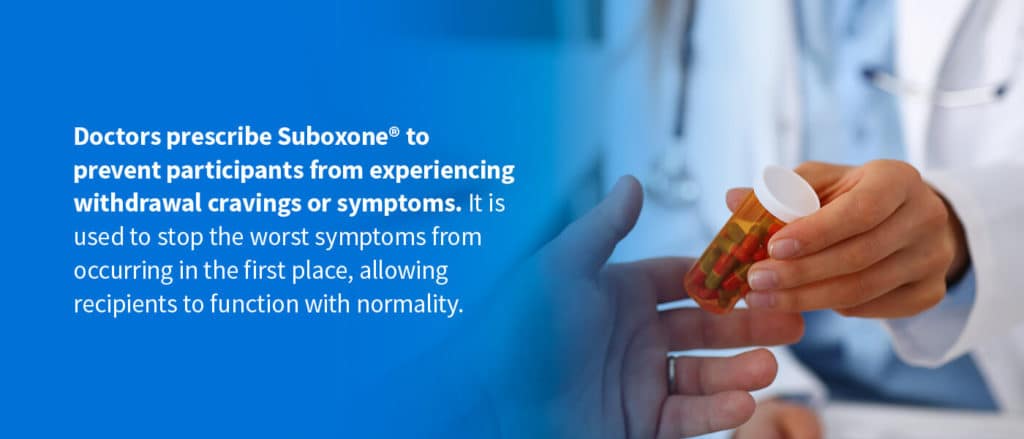Medication-assisted treatment (MAT) can be accomplished with many different medications. Buprenorphine, better known by its brand name Suboxone®, is an option for managing opioid addiction. Suboxone® is a combination of buprenorphine and naloxone, which decrease the severity of withdrawal symptoms and reduce long-term dependence on opioids. In an outpatient setting, Suboxone® treatment is used as an injectable medication for pain management. Even if you are using heroin or one of the other opioids, you can find help at an opioid treatment program (OTP).
Buprenorphine was approved by the FDA for clinical use in 2002, proven to be effective in opioid addiction treatment. A medical provider can prescribe this opioid treatment medication and fill it at any pharmacy. Are you a candidate for Suboxone® treatment? Read below to find out.

Is Suboxone® a Valid Treatment Option?
Doctors prescribe Suboxone® to prevent participants from experiencing withdrawal cravings or symptoms. It is used to stop the worst symptoms from occurring in the first place, allowing recipients to function with normality. When entering Suboxone® treatment, you should be willing to follow through with your physician’s recommended schedule of visits. You should also know all of the other medication-assisted treatment options.
According to the Substance Abuse and Mental Health Services Administration, buprenorphine treatment happens in three phases:
- Phase one: Candidates must meet certain Suboxone® qualifications before beginning treatment. The patient must be in the early stages of opioid usage and abstain from usage for 12 to 24 hours. The treatment then begins with a qualified physician performing a medication-assisted treatment of buprenorphine.
- Phase two: After the patient has reduced their opioid use or has discontinued their use, the stabilization phase can begin. This can include switching to alternate-day treatments instead of every day.
- Phase three: The treatment maintenance varies between patients. Once the patient is seeing progress on the continuous treatment of buprenorphine, the remainder of the treatment will meet the patient’s individual needs.
Suboxone® is included in a medication family called “opioid antagonists,” which is the opposite of “opioid agonists” like heroin, oxycodone and morphine. Suboxone® will cancel out the effects of opioids, allowing you to manage your cravings and reduce withdrawal symptoms. Its side effects are typically less severe and are physical instead of mental.
Suboxone® comes in two forms — a tablet or a sublingual film. Both of these dissolve into your mouth, offering the same results.
The most important aspect of recovering with Suboxone® treatment is to not use alcohol or other benzodiazepines. Combining these substances can seriously depress the central nervous system. Make sure all other opioids have completely cleared from your system before using Suboxone®. Wait until opioid withdrawal symptoms appear before taking your first dose of Suboxone®.
Buprenorphine Treatment vs. Methadone
Both methadone and buprenorphine stimulate the brain’s manufacture of biochemicals and are proven effective in treating opioid use disorder. However, the effects of buprenorphine are more limited. Learn more about the differences between the two treatment options and how they can affect a patient’s recovery process.
Buprenorphine
Buprenorphine has a “ceiling effect” that prevents the risk of misuse and side effects. People with mild to moderate opioid disorder will find it more effective than those with extremely high concentrations of opioids.
Buprenorphine offers a reduced degree of bioavailability, presenting a lesser potential for addiction. Your withdrawal symptoms can go away, allowing you to no longer experience any cravings.
Methadone
Methadone can only be dispensed at licensed clinics, whereas buprenorphine is FDA-approved to be taken at home. This is because methadone is highly regulated and categorized as a Schedule II drug by the DEA, whereas buprenorphine is categorized as a Schedule III drug. You may find that taking buprenorphine is an easier treatment option to work into your schedule if you choose to continue working or attending school.
Methadone is more affordable than buprenorphine because it’s been around much longer. That is also why there’s a chance your insurance might not cover it. Buprenorphine-naloxone formulations, such as Suboxone®, are at the upper end of the medication cost charts. In the long run, the extra expense of buprenorphine may even out if you plan to use it temporarily and taper off. This compares to using methadone for indefinite maintenance.
Buprenorphine or Methadone During Pregnancy
During pregnancy, it is crucial that women avoid opioids since they can cause issues, such as birth defects, premature births or miscarriages. For decades, methadone has been safely and successfully taken to prevent withdrawal symptoms throughout pregnancy and does not cause birth defects. Some babies may experience withdrawal, appearing as late as up to two weeks after birth. This does not mean they are addicted. Moms can also breastfeed safely while taking methadone.
Buprenorphine is recommended by the American College of Obstetricians and Gynecologists (ACOG) for treating pregnant women. There are fewer drug interactions and less need for dosage changes throughout the pregnancy.
Both medications are proven safe and effective for pregnant women. There is less evidence for buprenorphine, causing many medical providers to prefer the use of methadone during pregnancy.
Suboxone® Treatment and Counseling
Treatment works best when you combine it with behavioral counseling. A complete MAT plan integrates a carefully monitored medication regimen with individual, group and family counseling. Therefore, a Suboxone® prescription needs to be used at the same time as going to rehab or a drug treatment program. Suboxone® can’t help users learn strategies to avoid relapse in the future, which is why you should attend counseling, as well.
Individual Counseling
One-on-one counseling assists you with:
- Overcoming cravings for opioids
- Understanding addiction and relapse prevention techniques
- Implementing healthy coping mechanisms and ways to manage stress
- Developing other life skills to benefit your quality of life
- Building a happy and productive life in long-term recovery through planning and goal setting
- Gaining support systems in ongoing recovery
Group Counseling
Group counseling has the potential to be extremely effective in your comprehensive treatment plan. Group counseling gives patients the ability to share their feelings with others with similar experiences, which creates a sense of belonging. Additional group counseling benefits include:
- Patients are given new tools and strategies for problem-solving from others in recovery through sharing experiences and solutions.
- Patients realize that others have had similar experiences in and out of addiction, so feelings of guilt and shame can decrease.
- Patients can support and hold one another accountable for achieving their individual and group treatment goals.
- Patients are provided with the support needed to persevere through the difficulties of sobriety by building a support network of both friends and family.
Alcoholics Anonymous (AA), Narcotics Anonymous (NA) or other peer recovery groups can help you build and extend your recovery support systems.
Receive Suboxone® Treatment at AppleGate Recovery
If you think Suboxone® treatment is right for you, contact AppleGate Recovery. We have offices throughout the United States that specialize in Office-Based Opioid Treatment (OBOT). We have individualized Suboxone® treatment plans and counseling options, as well. Learn how to get started today.

